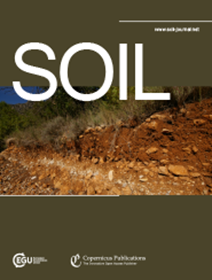A GLUE-based assessment of WaTEM/SEDEM for simulating soil erosion, transport, and deposition in soil conservation optimised agricultural watersheds
IF 4.3
2区 农林科学
Q1 SOIL SCIENCE
引用次数: 0
Abstract
Abstract. Soil erosion models are essential tools for soil conservation planning. Although these models are generally well-tested against plot and field data for in-field soil management, challenges arise when scaling up to the landscape level, where sediment trapping along landscape features becomes increasingly critical. At this scale, a separate analysis of model performance in representing erosion, sediment transport, and deposition processes is both challenging and often lacking. In this study, we assessed the capacity of the spatially distributed erosion and sediment transport model WaTEM/SEDEM to simulate sediment yields in six micro-scale watersheds ranging from 0.8 to 7.8 ha, monitored over eight years from 1994 to 2001. The watersheds were comprised of two groups: four field-dominated watersheds characterised by arable land with minimal landscape structures, and two structure-dominated watersheds featuring a combination of arable land and linear landscape structures (mainly grassed waterways along thalwegs) that minimise sediment connectivity. This setup enabled a separate analysis of model performance for both watershed groups. A Generalised Likelihood Uncertainty Estimation (GLUE) framework was employed to account for measurement and model uncertainties across multiple spatiotemporal scales. Our results show that while WaTEM/SEDEM generally captured the magnitude of the very low measured sediment yields in the monitored watersheds, the model did not meet our pre-defined limits of acceptability when operating on annual timesteps. However, the WaTEM/SEDEM's performance improved substantially when model realisations were aggregated across the eight-year monitoring period and over the two watershed groups, with mean absolute errors of 0.11 t ha⁻¹ yr⁻¹ for field-dominated and 0.18 t ha⁻¹ yr⁻¹ for structure-dominated watersheds. Our findings demonstrate that the model can represent the influence of soil conservation measures on reducing soil erosion and sediment delivery but performs better for long-term conservation planning at larger scales than for precise annual predictions in individual micro-scale watersheds with specific conservation practices.基于glue的WaTEM/SEDEM模拟水土保持优化农业流域土壤侵蚀、运移和沉积的评估
摘要。土壤侵蚀模型是土壤保持规划的重要工具。尽管这些模型通常已经在现场土壤管理中经过了很好的测试,但当扩大到景观水平时,就会出现挑战,因为沿着景观特征的沉积物捕获变得越来越重要。在这个尺度上,对模型性能进行单独分析,以代表侵蚀、泥沙运移和沉积过程,既具有挑战性,又常常缺乏。本研究评估了空间分布侵蚀输沙模型WaTEM/SEDEM对6个微尺度流域(0.8 ~ 7.8 ha)产沙量的模拟能力,监测时间为1994 ~ 2001年。流域由两组组成:四个以农田为主的流域,其特征是耕地和最小的景观结构,两个以结构为主的流域,其特征是耕地和线性景观结构(主要是沿着thalwegs的草地水道)的组合,最大限度地减少了沉积物的连通性。这种设置可以对两个分水岭组的模型性能进行单独分析。采用广义似然不确定性估计(GLUE)框架来考虑跨多个时空尺度的测量和模型不确定性。我们的研究结果表明,虽然WaTEM/SEDEM通常捕获了监测流域中非常低的测量产沙量的大小,但当按年度时间步长运行时,该模型不符合我们预先定义的可接受性限制。然而,当在8年的监测期间和两个流域组中汇总模型的实现时,WaTEM/SEDEM的表现有了很大的改善,对于以田地为主导的毒血症发展迟缓的平均绝对误差为0.11 t³³,对于以结构为主导的毒血症发展迟缓的平均绝对误差为0.18 t³³³。我们的研究结果表明,该模型可以代表土壤保持措施对减少土壤侵蚀和沉积物输送的影响,但在更大尺度上的长期保护规划比在个别微尺度流域具有特定保护措施的精确年度预测表现得更好。
本文章由计算机程序翻译,如有差异,请以英文原文为准。
求助全文
约1分钟内获得全文
求助全文
来源期刊

Soil
Agricultural and Biological Sciences-Soil Science
CiteScore
10.80
自引率
2.90%
发文量
44
审稿时长
30 weeks
期刊介绍:
SOIL is an international scientific journal dedicated to the publication and discussion of high-quality research in the field of soil system sciences.
SOIL is at the interface between the atmosphere, lithosphere, hydrosphere, and biosphere. SOIL publishes scientific research that contributes to understanding the soil system and its interaction with humans and the entire Earth system. The scope of the journal includes all topics that fall within the study of soil science as a discipline, with an emphasis on studies that integrate soil science with other sciences (hydrology, agronomy, socio-economics, health sciences, atmospheric sciences, etc.).
 求助内容:
求助内容: 应助结果提醒方式:
应助结果提醒方式:


